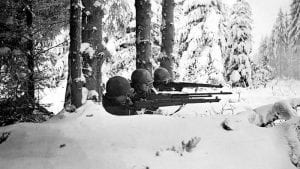 In Slaughterhouse-Five, I’ve noticed that Kurt Vonnegut has a very unique means of storytelling. The story follows the life and experiences of Billy Pilgrim, an American soldier during the Battle of the Bulge (1944). There’s a twist however: Billy has become “unstuck” in time. This means that at any point he could suddenly jump to another part of his life. Vonnegut uses this plot point in order to give the reader a piece of information about Billy’s past or future before jumping back to his time in the war.
In Slaughterhouse-Five, I’ve noticed that Kurt Vonnegut has a very unique means of storytelling. The story follows the life and experiences of Billy Pilgrim, an American soldier during the Battle of the Bulge (1944). There’s a twist however: Billy has become “unstuck” in time. This means that at any point he could suddenly jump to another part of his life. Vonnegut uses this plot point in order to give the reader a piece of information about Billy’s past or future before jumping back to his time in the war.
I find this format to be extremely effective. It characterizes Billy in a far more efficient manner than would be accomplished by simply characterizing him in the present, since the reader is shown a wider scope of Billy’s life. This format also aids the pacing of the story. Because of the periodical switch between the past/future and the present, neither part hangs around long enough to become stale. This is why I’ve yet to reach a part in the book that feels slow or tiresome. I hope to see this style continue throughout the rest of the novel.
Thank you for sharing, Jamin. I’m glad you are enjoying your reading so far, and I’ll look forward to seeing what you think of your novel when you are finished. What makes the part you are reading now seem slow? Is the author taking the time to provide more background?
In your comment, you provide a concise, yet important summary for the reader of your post. You not only summarize, but also reflect on the format the author uses in the way he writes. You also analyze how this is to the reader and the overarching plot. You address points that would be good for choosing a topic from.